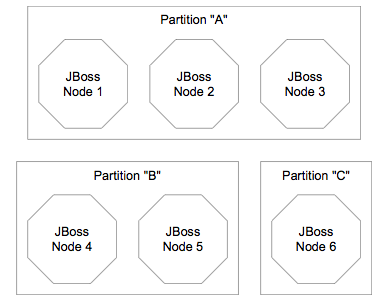A cluster is a set of nodes that communicate with each other and work toward a common goal. In a JBoss Application Server cluster (also known as a “partition”), a node is an JBoss Application Server instance. Communication between the nodes is handled by the JGroups group communication library, with a JGroups Channel providing the core functionality of tracking who is in the cluster and reliably exchanging messages between the cluster members. JGroups channels with the same configuration and name have the ability to dynamically discover each other and form a group. This is why simply executing “run -c all” on two AS instances on the same network is enough for them to form a cluster – each AS starts a Channel (actually, several) with the same default configuration, so they dynamically discover each other and form a cluster. Nodes can be dynamically added to or removed from clusters at any time, simply by starting or stopping a Channel with a configuration and name that matches the other cluster members. In summary, a JBoss cluster is a set of AS server instances each of which is running an identically configured and named JGroups Channel.
On the same AS instance, different services can create their own Channel. In a default 5.0.x AS, four different services create channels – the web session replication service, the EJB3 SFSB replication service, the EJB3 entity caching service, and a core general purpose clustering service known as HAPartition. In order to differentiate these channels, each must have a unique name, and its configuration must match its peers yet differ from the other channels.
So, if you go to two AS 5.0.x instances and execute run -c all, the channels will discover each other and you'll have a conceptual cluster. It's easy to think of this as a two node cluster, but it's important to understand that you really have 4 channels, and hence 4 two node clusters.
On the same network, even for the same service, we may have different clusters. Figure 16.1, “Clusters and server nodes” shows an example network of JBoss server instances divided into three clusters, with the third cluster only having one node. This sort of topology can be set up simply by configuring the AS instances such that within a set of nodes meant to form a cluster the Channel configurations and names match while they differ from any other channels on the same network.
The section on “JGroups Configuration” and on “Isolating JGroups Channels” covers in detail how to configure Channels such that desired peers find each other and unwanted peers do not. As mentioned above, by default JBoss AS uses four separate JGroups Channels. These can be divided into two broad categories: the Channel used by the general purpose HAPartition service, and three Channels created by JBoss Cache for special purpose caching and cluster wide state replication.
